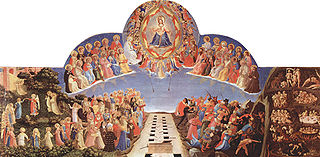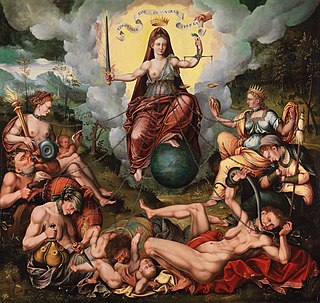
Gerard David was an Early Netherlandish painter and manuscript illuminator known for his brilliant use of color. Only a bare outline of his life survives, although some facts are known. He may have been the Meester gheraet van brugghe who became a master of the Antwerp guild in 1515. He was very successful in his lifetime and probably ran two workshops, in Antwerp and Bruges. Like many painters of his period, his reputation diminished in the 17th century until he was rediscovered in the 19th century.

The European Court of Human Rights, also known as the Strasbourg Court, is an international court of the Council of Europe which interprets the European Convention on Human Rights. The court hears applications alleging that a contracting state has breached one or more of the human rights enumerated in the convention or its optional protocols to which a member state is a party. The European Convention on Human Rights is also referred to by the initials "ECHR". The court is based in Strasbourg, France.

A diptych is any object with two flat plates which form a pair, often attached by hinge. For example, the standard notebook and school exercise book of the ancient world was a diptych consisting of a pair of such plates that contained a recessed space filled with wax. Writing was accomplished by scratching the wax surface with a stylus. When the notes were no longer needed, the wax could be slightly heated and then smoothed to allow reuse. Ordinary versions had wooden frames, but more luxurious diptychs were crafted with more expensive materials.
Hans Memling was a painter active in Flanders, who worked in the tradition of Early Netherlandish painting. Born in the Middle Rhine region, he probably spent his childhood in Mainz. During his apprenticeship as a painter he moved to the Netherlands and spent time in the Brussels workshop of Rogier van der Weyden. In 1465 he was made a citizen of Bruges, where he became one of the leading artists and the master of a large workshop. A tax document from 1480 lists him among the wealthiest citizens. Memling's religious works often incorporated donor portraits of the clergymen, aristocrats, and burghers who were his patrons. These portraits built upon the styles which Memling learned in his youth.

Adriaen Isenbrandt or Adriaen Ysenbrandt was a painter in Bruges, in the final years of Early Netherlandish painting, and the first of the Dutch and Flemish Renaissance painting of the Northern Renaissance. Documentary evidence suggests he was a significant and successful artist of his period, even though no specific works by his hand are clearly documented. Art historians have conjectured that he operated a large workshop specializing in religious subjects and devotional paintings, which were executed in a conservative style in the tradition of the Early Netherlandish painting of the previous century. By his time, the new booming economy of Antwerp had made this the centre of painting in the Low Countries, but the previous centre of Bruges retained considerable prestige.

Early Netherlandish painting, is the body of work by artists active in the Burgundian and Habsburg Netherlands during the 15th- and 16th-century Northern Renaissance period, once known as the Flemish Primitives. It flourished especially in the cities of Bruges, Ghent, Mechelen, Leuven, Tournai and Brussels, all in present-day Belgium. The period begins approximately with Robert Campin and Jan van Eyck in the 1420s and lasts at least until the death of Gerard David in 1523, although many scholars extend it to the start of the Dutch Revolt in 1566 or 1568–Max J. Friedländer's acclaimed surveys run through Pieter Bruegel the Elder. Early Netherlandish painting coincides with the Early and High Italian Renaissance, but the early period is seen as an independent artistic evolution, separate from the Renaissance humanism that characterised developments in Italy. Beginning in the 1490s, as increasing numbers of Netherlandish and other Northern painters traveled to Italy, Renaissance ideals and painting styles were incorporated into northern painting. As a result, Early Netherlandish painters are often categorised as belonging to both the Northern Renaissance and the Late or International Gothic.

The Groeningemuseum is a municipal museum in Bruges, Belgium, built on the site of the medieval Eekhout Abbey.
The threshold of originality is a concept in copyright law that is used to assess whether a particular work can be copyrighted. It is used to distinguish works that are sufficiently original to warrant copyright protection from those that are not. In this context, "originality" refers to "coming from someone as the originator/author", rather than "never having occurred or existed before".

Jan Provoost, or Jean Provost, or Jan Provost was a Belgian painter born in Mons.

Christ in Majesty or Christ in Glory is the Western Christian image of Christ seated on a throne as ruler of the world, always seen frontally in the centre of the composition, and often flanked by other sacred figures, whose membership changes over time and according to the context. The image develops from Early Christian art, as a depiction of the Heavenly throne as described in 1 Enoch, Daniel 7, and The Apocalypse of John. In the Byzantine world, the image developed slightly differently into the half-length Christ Pantocrator, "Christ, Ruler of All", a usually unaccompanied figure, and the Deesis, where a full-length enthroned Christ is entreated by Mary and St. John the Baptist, and often other figures. In the West, the evolving composition remains very consistent within each period until the Renaissance, and then remains important until the end of the Baroque, in which the image is ordinarily transported to the sky.

The Last Judgment is a painting by the Renaissance artist Fra Angelico. It was commissioned by the Camaldolese Order for the newly elected abbot, the humanist scholar Ambrogio Traversari. It is variously dated to c1425, 1425–1430 and 1431. It was originally sited in the church of Santa Maria degli Angeli and now is in the museum of San Marco, Florence. It is not to be confused with another Fra Angelico Last Judgement in the Gemäldegalerie, Berlin.

Bridgeman Art Library v. Corel Corp., 36 F. Supp. 2d 191, was a decision by the United States District Court for the Southern District of New York, which ruled that exact photographic copies of public domain images could not be protected by copyright in the United States because the copies lack originality. Even though accurate reproductions might require a great deal of skill, experience and effort, the key element to determine whether a work is copyrightable under US law is originality.

Sisamnes was, according to Herodotus' Histories, a corrupt royal judge active in the Persian empire during the reign of Cambyses II of Persia. When Cambyses learned that Sisamnes had accepted a bribe to influence a verdict, he had him promptly arrested and sentenced him to be flayed alive. He had the skin of the flayed Sisamnes cut into leather strips. Cambyses then appointed Otanes, the son of the condemned Sisamnes, as his father's judicial successor. In order to remind Otanes what happens to corrupt judges and not forget the importance of judicial integrity, Cambyses ordered that the new judge's chair be draped in the leather strips made from the skin of the flayed Sisamnes. Otanes later became a satrap in Ionia. Cambyses warned Otanes to continually keep in mind the source of the leather of the chair upon which he would be seated to deliberate and deliver his judgment. The story was also referred to by the first century Latin author Valerius Maximus in his Factorum ac dictorum memorabilium libri IX. Whereas in Herodotus' version Sisamnes' skin is cut into strips, Maximus has the skin stretched across the chair.

The Nursing Madonna, Virgo Lactans, or Madonna Lactans, is an iconography of the Madonna and Child in which the Virgin Mary is shown breastfeeding the infant Jesus. In Italian it is called the Madonna del Latte. It was a common type in painting until the change in atmosphere after the Council of Trent, in which it was rather discouraged by the church, at least in public contexts, on grounds of propriety.

Vigor Boucquet or Victor Boucquet was a Flemish painter known for his portraits and paintings of biblical subjects. He was mainly active in his native Veurne and its surroundings where he was in demand for altarpieces for the local churches and monasteries. He worked in the typical Flemish Baroque style of his time, with a tendency towards a somber realism.

The Flaying of Marsyas is a painting by the Italian late Renaissance artist Titian, probably painted between about 1570 and his death in 1576, when in his eighties. It is now in the Archbishop's Palace in Kroměříž, Czech Republic and belongs to the Archbishopric of Olomouc. It is one of Titian's last works, and may be unfinished, although there is a partial signature on the stone in the foreground.

Antoon, Antonius or Anthuenis Claeissens, Claessens, or Claeissins was a Flemish painter. His subjects were historical and allegorical scenes and portraits. He was a member of the Claeissens family of painters which played an important role in the art world in Bruges in the 16th century.

The Crucifixion and Last Judgement diptych consists of two small painted panels attributed to the Early Netherlandish artist Jan van Eyck, with areas finished by unidentified followers or members of his workshop. This diptych is one of the early Northern Renaissance oil on panel masterpieces, renowned for its unusually complex and highly detailed iconography, and for the technical skill evident in its completion. It was executed in a miniature format; the panels are just 56.5 cm (22.2 in) high by 19.7 cm (7.8 in) wide. The diptych was probably commissioned for private devotion.

The Last Judgment is a triptych of disputed authorship, either by Hieronymus Bosch, his workshop, or a collaboration between artist and workshop. It was created after 1486.

The Diptych of Maarten van Nieuwenhove is a 1487 painting by Hans Memling, showing on the left side the Virgin and Child, and on the right side Maarten van Nieuwenhove. It is now kept in the Old St. John's Hospital in Bruges. It is unsigned, but has invariably been attributed to Hans Memling since the middle of the 19th century.


















